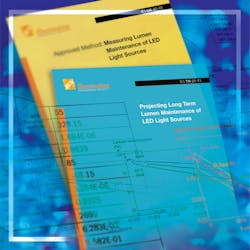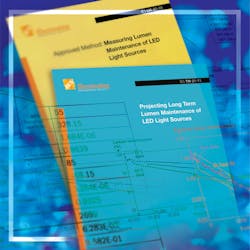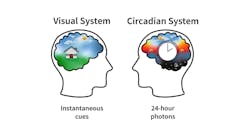JIANZHONG JIAO explains that the IES is publishing addendums to both the LM-80 standard for testing LEDs and documenting lumen maintenance, and to the TM-21 standard for projecting LED and SSL system life, improving and harmonizing the documents.
For continuous improvement in technology to be possible, it's critical that corresponding testing standards are established and continue to be reviewed and improved. The solid-state lighting (SSL) industry is no exception. In 2008, IES published LM-80 for recommending how to test LED lumen maintenance. Three years later TM-21 was published as a recommendation for projecting long-term lumen maintenance of LEDs using the test data collected per LM-80. Based on the continuous improvement principle, IES is in the process of publishing an addendum to LM-80 and TM-21.
LM-80 and TM-21 have been widely used by manufacturers, testing laboratories, government specifications, and in other ways. On a large scale, the overall LED lumen maintenance information provided and used in the industry has been more consistent since these two documents were published, which demonstrates their benefits.
At the time LM-80 was developed, experts in the IES committee believed that the test duration should be long enough so that sufficient data could be collected to use mathematical models to make a reliable projection. Furthermore, experts also believed that multiple LED case temperatures should be tested in order to make interpolations of the test data, as well as to make comparisons. For these reasons, the current LM-80 document specifies the test duration and requires a minimum of three case temperatures be tested.
Harmonizing LM-80 and TM-21
Right after LM-80 was published, a group of experts in the IES committee continued to develop TM-21. During several years of hard work in the TM-21 working group, experts developed many mathematical formulas based on the physics of LEDs' structures and materials, as well as an empirical data model to exemplify the LEDs' lumen decay behavior.
Meanwhile, experts in the TM-21 working group conducted numerous statistical analyses using more than 40 sets of LM-80 data collected by LED manufacturers and contributed to the TM-21 working group. In order to achieve the goal (desired by industry and governments) to have one universal model for making long-term lumen maintenance projections, pros and cons of each mathematical model were thoroughly studied in the working group. In the end, engineering judgment was used to derive the final approach presented in TM-21.
The method for interpolation of the in-situ temperature projection recommended in TM-21 requires the test data collected from two case temperatures, versus the original idea of three sets of data. In all practical cases, when an LED is used in an application (in-situ) in which its case temperature is different from the LM-80 test temperatures, the TM-21 instruction is to collect two case temperatures for LM-80 data — one above the in-situ temperature and another below the in-situ temperature — to make the interpolation. The third case temperature required by LM-80 does not have any relevance for such interpolation purposes.
LM-80 changes
Because LM-80 has been used for laboratory accreditation, the procedures listed in LM-80 must be followed so that an accredited LM-80 report is produced, which is required by the certification bodies (CBs). And in turn the CB's acceptance of an LM-80 report is the measure to meet market-transformation specifications such as Energy Star. For the purpose of compliance with LM-80, unnecessarily testing three case temperatures does not add value to TM-21; rather, it puts an additional burden on the industry. The LM-80 test is lengthy and often costly. If the IES document that sets the basis of all these consequences can be improved, it certainly is the right thing to do for the standard development bodies.
Improvement is the essential message for the LM-80 Addendum. This addendum provides new requirements in Section 4.4.2 as such: "At least one of the selected case temperatures shall be 55°C or 85°C. These case temperatures are commonly used for industry testing to support direct product comparisons of testing results." The requirement for a minimum of three case temperatures in the current version of LM-80 has been removed.
In the past few years, vast numbers of LM-80 tests have been performed at case temperatures of 55°C and 85°C. LM-80 data alone is not very meaningful for one-to-one comparisons, as the test duration is too short in term of LEDs' lumen decay behavior. The comparison usually takes place in the TM-21 projected results. However, if for any reason users want to select a case temperature to review more than one set of LM-80 data, the LM-80 Addendum will still meet this need.
TM-21 Addendum
As for the TM-21 Addendum, in the past two years of practice using TM-21, users raised several questions that need clarification. One question is regarding the LM-80 data collecting time interval tolerance. The current version of TM-21 states the data used for projection are collected in 500- or 1000-hour time intervals without specifying the time tolerance. In reality, the data collection often is not in the precise hour, and for the projection purposes, small variations of the time interval do not statistically affect the results. The TM-21 Addendum gives a tolerance of plus or minus 48 hours for collecting LM-80 data. Any data collected within this two-day window should be accepted as the 500- or 1000 hour mark. This clarification will help lab accreditation as well as the overall practice of testing.
The second issue that was expressed regarding TM-21 is the data interpolation. When two sets of LM-80 data are collected with a higher and lower case temperature, one set of data may have a longer testing duration than the other. It was not clear for the users how the interpolation should be made for these two sets of data with uneven test durations.
Per TM-21, test duration directly relates to the total projection period. For example, if a six-time multiplier is used, the projection is 60,000 hours for the 10,000 hour test data, but 36,000 hours for the 6000 hour test data. The TM-21 Addendum explains to users that in the situation with uneven length test durations, the projection can only be based on the test data set with the shorter duration. This is to ensure the acceptable confidence level in the projection result per statistics.
TM-21 extrapolations
The next clarification in the TM-21 Addendum is for the data extrapolation outside of the tested temperature range. The current TM-21 does not recommend the extrapolation for a temperature higher than the LM-80 tested case temperature, nor from the lower temperature. The engineering judgment for this requirement is that the LED always decays faster for higher junction or case temperatures. If that is the case regarding the physics, if the in-situ temperature is lower than the test temperature, the LED lumen decay should not be worse than the tested temperature.
The TM-21 Addendum has therefore added clarification that the extrapolation can't be performed for the in-situ temperature higher than the LM-80 tested temperature. However, if the in-situ temperature is lower than the tested temperature, the tested temperate can still represent the long-term lumen maintenance projection for the lower in-situ temperature.
The fourth issue is related to the TM-21 report. The current version of the TM-21 report includes two values: calculated lumen maintenance life (e.g., L70) and reported lumen maintenance life. The question is why there are two values, and what was the intent for reporting these two values?
TM-21 users have not had a common or correct understanding. Sometimes users employ the calculated values to make a comparison and to assume that LEDs with longer calculated values may have longer lumen maintenance life. In turn, the users may employ such judgment to select LEDs. Even though several LEDs were having the same reported L70, the users believed the calculated values mattered. That is a completely incorrect assumption.
At the time TM-21 was developed, the working group established a tool to take the mathematical model and LM-80 test data into calculations, and to derive the calculated results for projection. In order to help users calibrate the tool, two examples of calculations were listed in Annex E using real sets of LM-80 test data. The calculated projection values for lumen maintenance life (e.g., L70) were listed in the examples and the reports, so users could compare if the tool they were programming would get the same or identical results as the examples in Annex E to ensure the tool was working correctly. The tool that the working group developed and used happened to be developed in MS Excel. According to the IES non-commercialism policy, an IES document can't embed a commercial product that may be interpreted as a promotion for MS Excel. That was the sole purpose of listing a calculated value for L70 without putting MS Excel sheets in the current TM-21.
Removing calculated projections
Shortly after TM-21 was published, Energy Star released an MS Excel-based calculator. The tool for calculating lumen maintenance projection became publicly available. The Energy Star calculator has been verified by the NIST experts and other individuals and showed no errors in calculations. Therefore, the calculated value for the lumen maintenance projection has been verified and no longer needs to be listed.
The basic need to set multipliers in the lumen maintenance projection is the degree of confidence for the statistical uncertainty. Because the confidence level is associated with the length of test duration, and longer durations represent a higher confidence level, TM-21 specifically requires a notation to tell users how many hours of test data are used in the calculation. Beyond the time length calculated by multipliers, the projection result will exceed the confidence level allowed by TM-21; thus, any lumen maintenance values are no longer practically meaningful. Having the calculated value listed in the report and interpreted by someone to use as the comparison has misled users and consumers. In the TM-21 Addendum, the calculated lumen maintenance values are removed from all places.
In most cases, LED and SSL related IES documents, LMs, and TMs are the basis of continuous improvement following the ANSI accreditation process. The improvement can be demonstrated via addendums, and in the next revision of the IES document, the addendums will be fully integrated into the new version of the LM or TM document.
DR. JIANZHONG JIAO, Director of Regulations and Emerging Technologies at OSRAM Opto Semiconductors, Inc., is an internationally recognized lighting expert. He has been actively involved in LED and SSL standard development activities. He serves as the past Chairman of the SAE Lighting Committee, past Chairman of NGLIA, past Chairman of the NEMA SSL Technical Committee, active member of IESNA Testing Procedure Committee, Roadway Lighting Committee, and Computer Committee, ANSI SSL Working Groups, Standard Technical Panel of UL8750, standard committees in IEEE, CIE USA, SEMI, JEDEC and other organizations. He can be reached at [email protected].








